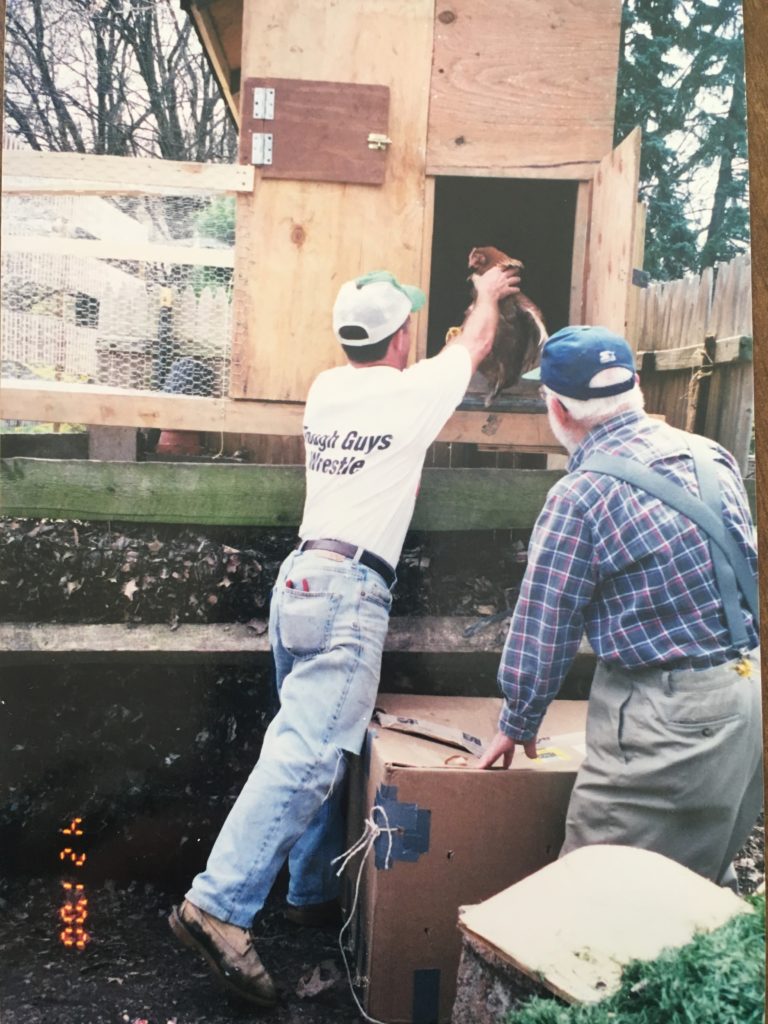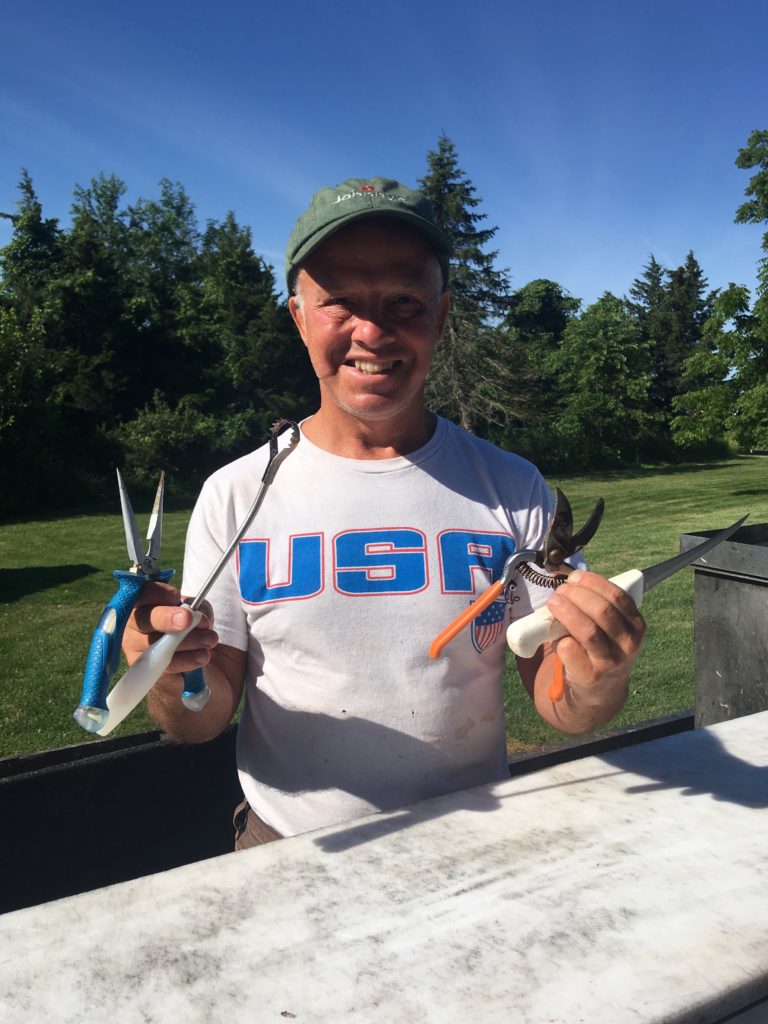Matthew Wilkinson shares the early lessons he learned about raising and processing chickens.
That Initial Excitement
As soon as my daughter had blown out her fifth year birthday candles, I saw my opportunity. I approached my wife, knowing she was in a weakened state from this joyous celebration. I did not hesitate however, blurting out the question, “Let’s get Eleanor a few chickens for her birthday!” Before my wife could come to grips with my request, I quickly followed up my question with the one-two punch and proclaimed how good it would be for our daughter’s development as a person! After all, kids need to feel responsible for things – taking ownership and following through on such tasks as taking care of an animal. Much to my shock, my wife agreed, and Eleanor was getting an additional birthday present: three Rhode Island Red egg layers.

Matt with beautiful chicken. Photo by Janelle Wilkinson.
I had anticipated my wife’s softened emotional state perfectly. And I had done my research on chicken breeds. Janelle, my wife, has beautiful long red hair and the possibility of getting a chicken with matching red feathers was an added bonus to the proposal! I never let it be known, but I was more excited over our future family addition than my daughter.
Help from Dad
My father had grown up in rural Indiana, and was my closest chicken expert. He volunteered to help build the chicken house, or as I later learned, chicken coop! I was very proud of my coop design. It was to be a small building with an outdoor run that was constructed to sit off the ground, over our compost pile. The coop would be positioned on steel wheels that rolled on a track. Think garage door. I envisioned all the chicken poop neatly falling into my compost pile making our vegetable garden the envy of the neighborhood!
The Perfect First Coop…Almost
I had the coop set up so the chickens could make their own deposits into the compost pile, and then when I needed, I could wheel the chicken coop away from the pile, allowing me easy access to the steamy heap of gardeny goodness.

The first coop and first chicken. Matt and his dad, April 2000. Photo by Janelle Wilkinson.
This nifty coop design would be my first inkling that there was much to learn about chicken ownership! I had done the research. The coop had to correct amount of space per chicken and enough open run space to prevent stress and anxiety in my birds. I had carefully positioned the egg laying box the recommended distance off the coop floor and now I felt great about my chicken stewardship.
That was until I went to clean the coop and turn the compost pile. The coop was too heavy to be moved by a single person. I had to ask my wife for help. Let me tell you, that did not go over too well! I then found out it was a major chore to clean out a coop raised off the ground. The chicken learning curve was steep and at times painfully slow for me. I did get hooked on this first batch of chickens and by-and-large it was very easy to care for the three ladies. The biggest take away from those first two years of having our four Rhode Island Reds was the need for efficiency.
Short Honeymoon
The first month of owning chickens is like falling in love for the first time. My chicken universe was filled with delirium and overflowing with exuberance. Nothing involving the chickens seemed tedious. I found myself wandering out to the coop just to say hello and watch them being their beautiful selves. I was blinded by chicken love.
But a couple years of chicken wrangling began to take its toll. The daily jobs of providing feed and water started to feel like work. I had to problem-solve frozen water tanks, the appearance of rats, and neighbors who questioned the legality of chicken ownership. The honeymoon was over.
What??? Chickens Don’t Lay Eggs Forever?
About that time, I started to notice a decline in the number of eggs we were collecting. I knew about chicken molt: when the chickens shed their feathers and put on a new coat. During the molt period, chickens put their energy into the growth of new feathers, and egg production would decline. But this new decline wasn’t a result of molt.

People who love chickens also love helping other people who own chickens. I sought the council of my chicken mentors and found out, much to my horror, that chickens start to drop in egg production at the tail end (pun intended) of their second year. What??? How dare those chickens!
Pragmatic Decisions
Among many other things, I am a pragmatist. I gave thought to the current state of my chickens and simply concluded that I would butcher them and get new ones. When I made the announcement, I quickly found myself spending the night on our living room couch. Boy were my wife and daughter upset! I plotted my strategy and decided I would learn what equipment was needed to take a chicken to the afterlife and find someone to guide me through the necessary steps of butchering a chicken. Then I would send my family away on a mini vacation and do the deed. Easy-peasy!
Learning How to Butcher
As it turned out, taking a chicken’s life wasn’t something my mentors had done. They had heard of processing a chicken. There were tales of grandparents who had been seen heading out to the woodshed with chicken and axe in hand. To us, it was all farming folklore but we had no practical experience. I was going to have to drag myself through the process on my own.
I scoured the internet on the topic and found a few descriptions of the steps required in processing one’s own chicken. There were a bunch of new vocabulary I was being forced to decipher: scalding, plucking, and eviscerating, to name a few. I found an old traffic cone, and quickly separated the cone from its square bottom support piece, making it a “killing cone”. Then I located a canning pot which would act as my scalding pot. I read that scalding water had to be around 149 degrees to achieve the best results. I should have paid more attention to the “best” results part of scalding. I planned to pluck the birds’ feathers myself, not having the know-how to assemble one of those wiz-bang chicken pluckers found on the internet.
This will be Easy, Right?
Everything seemed pretty straightforward. I set the date, sent my family off, and gathered the equipment and waited. I don’t remember feeling any different towards the birds as the send-off date approached. Even so, I must have been going through some kind of physical and mental preparation because the night before my chicken send-off party, I could not sleep. I started to doubt my ability to follow through. Could I really do this, take my own chickens lives?

Matt with processing tools. Photo by Janelle Wilkinson.
Taking a Life
Chickens are not the easiest of creatures to capture. My three Rhode Island Reds certainly knew something was up. They wanted no part of me. It did not help that I captured them in the middle of the day. Another lesson I would learn and improve upon for the future thousands of chickens I would come to process in the years to follow. But for now, I was as green as the grass that the chickens loved to eat! I held that first chicken in my arms, trying not to look into its little eyes. I flipped it upside down and shoved it into the traffic cone. At that point I had never thought of taking a creature’s life as it stared at me upside down. The chicken looked pretty ridiculous but I felt nothing but fear. Ironically, that was the situation we both found ourselves in. I latched onto the chicken’s jawbone and pulled its neck taut. I don’t know how but at that point, I felt my heart slow down and I became very, very calm. I instinctively knew that the best thing for the wild eyed chicken was for me to be super focused. There was no hesitating. Only after the warm sticky blood began to gush over my now trembling hand, did I realize what I had just done. There was no sugar coating it. I had ended a living being’s life. The next two birds were no easier to dispatch.
Pre-Cooking is Not the Way to Go
Somehow, I managed to finish the task and now considered step two, the scalding water. At this point, I began to understand why no one knew anything about chicken processing. It was a job no ever wanted to do. I held each chicken by its feet and began dunking the birds up and down in the steaming water. I was careful to keep my motion very rhythmic, making sure the birds stayed in the water until they looked scalded.
To me, scalding meant the chicken’s feathers were loose. I finished scalding all the birds only to realize that the legs of two of my chickens were separating from the main part of their bodies. I had failed to realize there was a chance of over-scalding. The birds were kept in too hot of a water bath. I had cooked my chickens! Yet another lesson learned.
Keeping Going
Feather plucking was pretty straightforward, yet very smelly. Wet feathers have a certain special aroma only they can create. When finished, I sat in disbelief looking at three very scrawny chickens’ bodies. I then learned the difference between meat birds and egg layers when it came to available muscle mass. Egg layers were breed for laying eggs, not eating!
By now I was emotionally drained and just wanted to cry uncle and call it a day. Even so, I knew I had to keep going. I could not waste the birds that had given so much to us.
The task of taking off the head, feet and innards of a chicken is both technical and downright messy. I experienced firsthand what “butchering” something looked and felt like. I made such a mess out of those birds. Yet I finished and had something to show for it.
A Lot of Lessons Learned
Despite the difficult ending to this entire experience, I learned that I loved owning chickens. And my family fell head-over-heels in love with them. There were so many moments of joy and celebration with those three lovely ladies, but I was also presented with many challenges, where I either had made a mistake or needed to problem solve. I was however, able to learn and develop as a person in my journey with these wonderful creatures. In the end, I’m so glad I initially educated myself on what it means to truly care for a chicken, since it entailed so much more than I had imagined. I owed it to myself, but more importantly, I owed it to the birds.
Matthew Wilkinson is known for his humor, knowledge, and easy-to-understand explanations of homesteading techniques and systems. Wilkinson and his family own and operate Hard Cider Homestead in rural East Amwell, New Jersey.
If you are interested in processing your own birds, our Editor recommends Meredith Leigh’s The Ethical Meat Handbook.













1 Comment
This was the most helpful chicken raising article I’ve ever read. Wonderfully written.